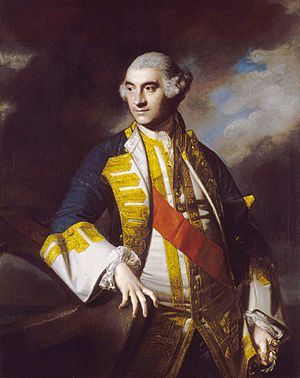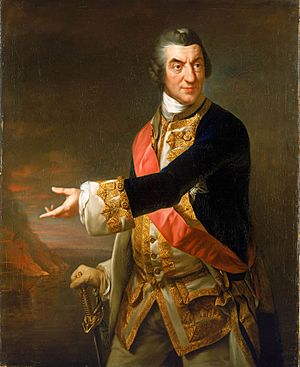Charles Saunders (Royal Navy officer) facts for kids
Quick facts for kids
Sir Charles Saunders
|
|
|---|---|

Sir Charles Saunders by Sir Joshua Reynolds
|
|
| Born | 1715 London, England |
| Died | 7 December 1775 (aged 59–60) London, England |
| Buried | |
| Allegiance | |
| Service/ |
|
| Years of service | 1727–1766 |
| Rank | Admiral |
| Commands held | HMS Plymouth HMS Sapphire HMS Dunkirk HMS Gloucester HMS Yarmouth HMS Tiger Mediterranean Fleet Western Squadron |
| Battles/wars | War of the Austrian Succession Seven Years' War |
| Awards | Knight of the Order of the Bath |
Sir Charles Saunders (born around 1715 – died December 7, 1775) was an important officer in the Royal Navy, which is the navy of Great Britain. He is best known for his role in helping the British capture Quebec during the Seven Years' War. He also held very high positions in the navy, becoming the First Lord of the Admiralty, which was like being the head of the entire British Navy.
Contents
Charles Saunders was born in London, England, around 1715. His father was James Saunders. Charles joined the Royal Navy in October 1727 when he was about 12 years old. He started as a midshipman, which was a junior officer rank.
He served on several ships, including HMS Seahorse and HMS Hector. In 1734, he was promoted to lieutenant. This meant he was a more senior officer on a ship. He continued to move between different ships, gaining experience.
In 1743, he became a post-captain. This was a big promotion, making him the official captain of a warship. He commanded ships like HMS Plymouth, HMS Sapphire, and HMS Dunkirk.
Fighting in the War of the Austrian Succession
In 1747, during the War of the Austrian Succession, Saunders commanded HMS Gloucester. He led his ship in a major sea battle called the Second Battle of Cape Finisterre. This battle was a victory for the British. After this, he commanded HMS Yarmouth and HMS Tiger.
In 1752, Saunders was made a Commodore. This meant he was in charge of a group of ships, or a squadron, in Newfoundland. He also took on important administrative roles. In 1754, he became the treasurer of Greenwich Hospital. In 1755, he was made the Comptroller of the Navy. This job involved managing the navy's supplies and finances.
Saunders also became a Member of Parliament. He represented Plymouth from 1750 to 1754. Then he represented Hedon, a town in Yorkshire, from 1754 until he died.
Leading in the Seven Years' War
In 1756, Saunders was promoted to rear-admiral. He was sent to Gibraltar as the second-in-command of the British fleet in the Mediterranean Sea. The next year, he became the Commander-in-Chief of the Mediterranean Fleet.
From late 1758 to mid-1759, he was the Commander-in-Chief of the English Channel fleet. This was a very important role, protecting Britain's home waters.
The Quebec Expedition
In January 1759, Saunders was given a huge task. He was put in command of the fleet that would carry General James Wolfe and his army to Quebec in Canada. Quebec was a very important French city. Saunders was promoted to vice admiral in February 1759.
His fleet successfully transported Wolfe's army up the Saint Lawrence River. This was a difficult journey. After the famous Battle of the Plains of Abraham in September 1759, General Wolfe was killed. Saunders then played a crucial role in making sure the British army, now led by Colonel George Townshend, had all the supplies they needed. This helped secure the British victory. Saunders and Townshend were the ones who signed the agreement when the French forces in Quebec surrendered.
In 1760, he went back to being Commander-in-Chief of the Mediterranean Fleet. He successfully blocked the French and Spanish fleets in Cádiz, preventing them from sailing. In 1761, he was made a Knight of the Order of the Bath, which is a special honor. In 1762, his fleet captured a Spanish treasure ship called Hermione. This was a very valuable prize.
Later Career and High Office
In 1765, Saunders joined the Board of Admiralty. This was the group of people who ran the Royal Navy. He became the Senior Naval Lord, which was a very high position.
In September 1766, he was promoted even further to First Lord of the Admiralty. This made him the most senior person in charge of the entire British Navy. However, he disagreed with Lord Chatham, a powerful politician, and left the Admiralty Board in December 1766.
On October 18, 1770, he was promoted to full Admiral. Sir Charles Saunders died at his home in London on December 7, 1775. He was buried in Westminster Abbey, a very famous church where many important British figures are laid to rest.
Legacy
Cape Saunders, a place on the coast of New Zealand, was named after him. This was done by Captain James Cook, who had served under Sir Charles Saunders during the campaign in Canada.
Images for kids






